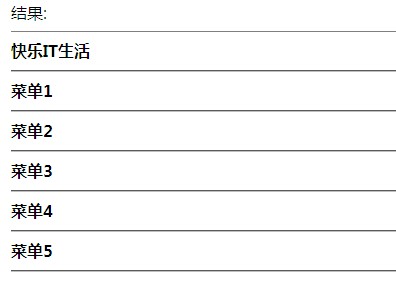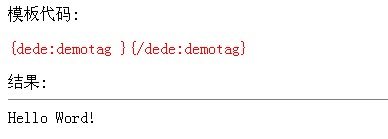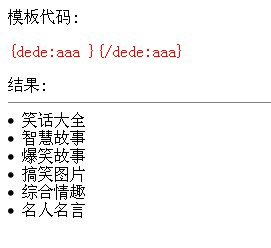You are here
Dedecms之自定义标签 有大用 有大大用

现在要做一个城市列表标签:要从城市表中获取数据并显示在页面上,系统本身不存在这样的标签,标签取名为citylist
文件部署:自定义标签的程序文件放在/include/taglib目录下
命名规范:标签程序的文件命名为[标签名称]+‘.lib.php’
即在/include/taglib目录下,新建一个文件,名为citylist.class.php
编码规范:
<?php
if(!defined('DEDEINC'))
{
exit("Request Error!");
}
function lib_demotag(&$ctag,&$refObj)
{
global $dsql,$envs;
//属性处理
$attlist="row|12,titlelen|24";
FillAttsDefault($ctag->CAttribute->Items,$attlist);
extract($ctag->CAttribute->Items, EXTR_SKIP);
$revalue = '';
//你需编写的代码,不能用echo之类语法,把最终返回值传给$revalue
//------------------------------------------------------
$revalue = 'Hello Word!';
//------------------------------------------------------
return $revalue;
}
?>
以上代码可通过如下方式查看:后台 - 模板 - 标签源码管理 ,点击页面的右上角[增加一个新的标签]链接进入页面
函数的命名规范:lib_+标签名称,我们的标签函数名称为lib_citylist,两个参数(ctag,refObj)原封不动
具体实现:
function lib_citylist(&$ctag, &$refObj)
{
global $dsql, $envs, $_sys_globals;
====必须的代码=====
$attlist = "row|10";
FillAttsDefault ( $ctag->CAttribute->Items, $attlist );
extract ( $ctag->CAttribute->Items, EXTR_SKIP );
====必须的代码=====
====数据获取=====
$condtion="";
$revalue='';
$equery="Select id,sortid,att,attname From tbl_city";
if(trim($ctag->GetInnerText())=='') $innertext = "[field:attname /]";
else $innertext = $ctag->GetInnerText();
$dsql->SetQuery($equery);
$dsql->Execute();
====数据获取=====
====标签替换=====
while($dbrows=$dsql->GetObject())
{
$rbtext = preg_replace("/
field:attname([\/\s]0,) /isU",$dbrows->attname, $innertext);
$rbtext = preg_replace("/
field:att([\/\s]0,) /isU",$dbrows->att, $rbtext);
$revalue.=$rbtext;
}
$revalue = preg_replace("/
field:tid([\/\s]0,) /isU",$_GET['tid'], $revalue);
$revalue = preg_replace("/
field:price([\/\s]0,) /isU",$_GET['price'], $revalue);
$revalue = preg_replace("/
field:is3g([\/\s]0,) /isU",$_GET['is3g'], $revalue);
====内容返回=====
return $revalue;
}
在模板中的应用:
{dede:citylist row=10} --- 内容循环,属性值传递
<li><a href="list.php?tid=[field:tid /]&price=[field:price /]&citycode=[field:att /]&is3g=[field:is3g /]" >[field:attname /]</a></li>
{/dede:citylist}
版权声明:本文为博主原创文章,未经博主允许不得转载。
来自 http://blog.csdn.net/haigou20/article/details/8618082
Dedecms之自定义标签
看了PHP和Dedecms有三天了,记录一下自定义标签的笔记。
我拿一个简单的标签flink来解释一下:
<?php//检查是否定义include文件夹的路径DEDEINC<br> if(!defined('DEDEINC')){ exit("Request Error!");}//写标签时,默认调用的方法function lib_flink(&$ctag,&$refObj){//声明全局的数据库连接 FillAttsDefault($ctag->CAttribute->Items,$attlist);//将标签中的值导入到当前符号表中<br> $totalrow = $row; $revalue = ''; //以下为拼装SQL查询语句 $wsql = " where ischeck >= '$linktype' "; if($typeid == 0) { $wsql .= ''; } else { $wsql .= "And typeid = '$typeid'"; } if($type=='image') { $wsql .= " And logo<>'' "; } else if($type=='text') { $wsql .= " And logo='' "; } $equery = "Select * from #@__flink $wsql order by sortrank asc limit 0,$totalrow"; //检查标记中是否已经包含innertext底层模板 if(trim($ctag->GetInnerText())=='') $innertext = "<li>[field:link /]</li>"; else $innertext = $ctag->GetInnerText(); //设置查询条件并执行查询 $dsql->SetQuery($equery); $dsql->Execute(); //通过循环获取查询的对象<br> while($dbrow=$dsql->GetObject()) {if($type=='text'||$type=='textall') { $link = "<a href='".$dbrow->url."' target='_blank'>".cn_substr($dbrow->webname,$titlelen)."</a> "; } else if($type=='image') { $link = "<a href='".$dbrow->url."' target='_blank'><img src='".$dbrow->logo."' width='88' height='31' border='0'></a> "; } else { if($dbrow->logo=='') { $link = "<a href='".$dbrow->url."' target='_blank'>".cn_substr($dbrow->webname,$titlelen)."</a> "; } else { $link = "<a href='".$dbrow->url."' target='_blank'><img src='".$dbrow->logo."' width='88' height='31' border='0'></a> "; } } //对innertext中的字符串进行值替换(暂时不清楚为什么标签里面的row只是一个数值,但是却在这里能成为一个数组,求解答)<br> $rbtext = preg_replace("/\[field:url([\/\s]{0,})\]/isU", $row['url'], $innertext); $rbtext = preg_replace("/\[field:webname([\/\s]{0,})\]/isU", $row['webname'], $rbtext); $rbtext = preg_replace("/\[field:logo([\/\s]{0,})\]/isU", $row['logo'], $rbtext); $rbtext = preg_replace("/\[field:link([\/\s]{0,})\]/isU", $link, $rbtext); $revalue .= $rbtext; } //返回替换处理好的字符串<br> return $revalue;}?> |
如果有读者对方法的参数&$ctag,&$refObj不是很清楚,请从index.php中的处理开始查看,具体的应该是在include目录下的Dedetag.class.php中。
下面,我们仿照上面的例子自己去写一个标签
<?php if (! defined ( 'DEDEINC' )) { exit ( "Request Error!" ); } function lib_aaa(&$ctag, &$refObj) { global $dsql; $attlist = "topid|0,row|10"; FillAttsDefault ( $ctag->CAttribute->Items, $attlist ); extract ( $ctag->CAttribute->Items, EXTR_SKIP ); $condtion=""; $revalue=''; if($topid==0) { $condtion.=" where topid=0"; } elseif ($topid!=0) { $condtion.=" where topid <> 0"; } $equery="select * from `#@__arctype` $condtion"; if(trim($ctag->GetInnerText())=='') $innertext = "<li>[field:typename /]</li>"; else $innertext = $ctag->GetInnerText(); $dsql->SetQuery($equery); $dsql->Execute(); while($dbrows=$dsql->GetObject()) { $rbtext = preg_replace("/\[field:typename([\/\s]{0,})\]/isU",$dbrows->typename, $innertext); $revalue.=$rbtext; } return $revalue; }?> |
上面的代码比较简单,在这里就不做解释了,直接看测试结果:
//这个测试不包含innertext,默认输出应该是<li><br>{dede:aaa topid='0'row=10}{/dede:aaa} |
输出结果:

//自带的innertext,应该输出是按照加粗+分割线格式{dede:aaa topid='0' row=10}<b>[field:typename /]</b><hr />{/dede:aaa} |
输出结果:

声明:本人菜鸟这几天在学PHP的Dedecms时发现能用的资料并不是很多,而且关于自定义标签的解读也很少,所以记录下来,希望出错的地方大家能提出,帮助我进步!
来自 http://www.cnblogs.com/matrix-power/archive/2011/04/11/Matrix.html
dedecms自定义标签的方法,胡鹏博客给出一个简单的解析及举例说明
首先我们来看dedecms一个现成的标签flink(友情链接标签),然后我们根据flink标签自己写一个简单的标签,这样我们就很容易掌握用dedecms自定义标签了。我们看代码:登录dedecms后台=》模板=》标签源码管理=》flink.lib.php
里面的代码如下:
<?php//检查是否定义include文件夹的路径DEDEINCif(!defined('DEDEINC'))
{
exit("Request Error!");
}
//写标签时,默认调用的方法function lib_flink(&$ctag,&$refObj){// 声明全局的数据库连接 global $dsql; //标签拥有的属性和默认值 $attlist="type|textall,row|24,titlelen|24,linktype|1,typeid|0"; FillAttsDefault($ctag->CAttribute->Items,$attlist); //将标签中的值导入到当前符号表中 extract($ctag->CAttribute->Items, EXTR_SKIP); $totalrow = $row; $revalue = ''; //以下为拼装SQL查询语句 $wsql = " where ischeck >= '$linktype' "; if($typeid == 0) { $wsql .= ''; } else { $wsql .= "And typeid = '$typeid'"; } if($type=='image') { $wsql .= " And logo<>'' "; } else if($type=='text') { $wsql .= " And logo='' "; } $equery = "Select * from #@__flink $wsql order by sortrank asc limit 0,$totalrow"; //检查标记中是否已经包含innertext底层模板 if(trim($ctag->GetInnerText())=='') $innertext = "<li>[field:link /]</li>"; else $innertext = $ctag->GetInnerText(); //设置查询条件并执行查询 $dsql->SetQuery($equery); $dsql->Execute(); //通过循环获取查询的对象 while($dbrow=$dsql->GetObject()) {if($type=='text'||$type=='textall') { $link = "<a href='".$dbrow->url."' target='_blank'>".cn_substr($dbrow->webname,$titlelen)."</a> "; } else if($type=='image') { $link = "<a href='".$dbrow->url."' target='_blank'><img src='".$dbrow->logo."' width='88' height='31' border='0'></a> "; } else { if($dbrow->logo=='') { $link = "<a href='".$dbrow->url."' target='_blank'>".cn_substr($dbrow->webname,$titlelen)."</a> "; } else { $link = "<a href='".$dbrow->url."' target='_blank'><img src='".$dbrow->logo."' width='88' height='31' border='0'></a> "; } } // 对innertext中的字符串进行值替换(暂时不清楚为什么标签里面的row只是一个数值,但是却在这里能成为一个数组,求解答) $rbtext = preg_replace("/\[field:url([\/\s]{0,})\]/isU", $row['url'], $innertext); $rbtext = preg_replace("/\[field:webname([\/\s]{0,})\]/isU", $row['webname'],$rbtext); $rbtext = preg_replace("/\[field:logo([\/\s]{0,})\]/isU", $row['logo'], $rbtext); $rbtext = preg_replace("/\[field:link([\/\s]{0,})\]/isU", $link, $rbtext); $revalue .= $rbtext; } //返回替换处理好的字符串 return $revalue;}?>下面,我们仿照上面的例子自己去写一个标签
<?php
if (! defined ( 'DEDEINC' )) {
exit ( "Request Error!" );
}
function lib_aaa(&$ctag, &$refObj)
{
global $dsql;
$attlist = "topid|0,row|10";
FillAttsDefault ( $ctag->CAttribute->Items, $attlist );
extract ( $ctag->CAttribute->Items, EXTR_SKIP );
$condtion="";
$revalue='';
if($topid==0)
{
$condtion.=" where topid=0";
}
elseif ($topid!=0)
{
$condtion.=" where topid <> 0";
}
$equery="select * from `#@__arctype` $condtion";
if(trim($ctag->GetInnerText())=='') $innertext = "<li>[field:typename /]</li>";
else $innertext = $ctag->GetInnerText();
$dsql->SetQuery($equery);
$dsql->Execute();
while($dbrows=$dsql->GetObject())
{
$rbtext = preg_replace("/\[field:typename([\/\s]{0,})\]/isU",$dbrows->typename, $innertext);
$revalue.=$rbtext;
}
return $revalue;
}
?>
如果有读者对方法的参数&$ctag,&$refObj不是很清楚,请从index.php中的处理开始查看,具体的应该是在include目录下的Dedetag.class.php中,下面我们来写一个最简单的helloword标签
<?php
if(!defined('DEDEINC'))
{
exit("Request Error!");
}
function lib_demotag(&$ctag,&$refObj)
{
global $dsql,$envs;
//属性处理
$attlist="row|12,titlelen|24";
FillAttsDefault($ctag->CAttribute->Items,$attlist);
extract($ctag->CAttribute->Items, EXTR_SKIP);
$revalue = '';
//你需编写的代码,不能用echo之类语法,把最终返回值传给$revalue
//------------------------------------------------------
$revalue = 'Hello Word!';
//------------------------------------------------------
return $revalue;
}
?>
效果图如下所求:
下面我们再写一个难度大一点的自定义标签的代码如下
<?php
if (! defined ( 'DEDEINC' )) {
exit ( "Request Error!" );
}
function lib_aaa(&$ctag, &$refObj)
{
global $dsql;
$attlist = "topid|0,row|10";
FillAttsDefault ( $ctag->CAttribute->Items, $attlist );
extract ( $ctag->CAttribute->Items, EXTR_SKIP );
$condtion="";
$revalue='';
if($topid==0)
{
$condtion.=" where topid=0";
}
elseif ($topid!=0)
{
$condtion.=" where topid <> 0";
}
$equery="select * from `#@__arctype` $condtion";
if(trim($ctag->GetInnerText())=='') $innertext = "<li>[field:typename /]</li>";
else $innertext = $ctag->GetInnerText();
$dsql->SetQuery($equery);
$dsql->Execute();
while($dbrows=$dsql->GetObject())
{
$rbtext = preg_replace("/\[field:typename([\/\s]{0,})\]/isU",$dbrows->typename, $innertext);
$revalue.=$rbtext;
}
return $revalue;
}
?>
来自 http://www.seostudying.com/1511.html


